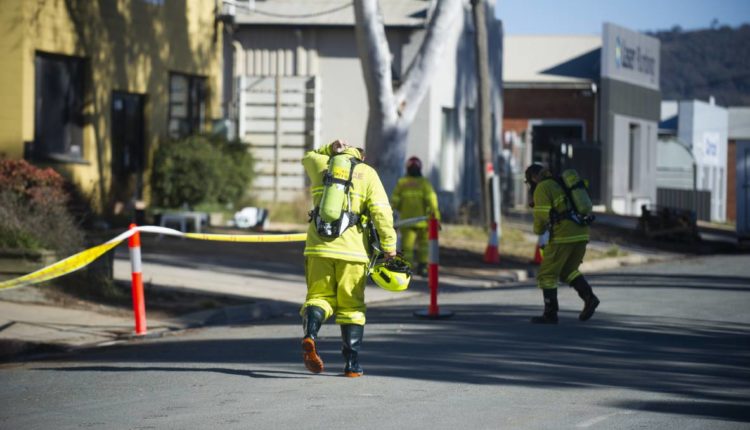Canberra rooftop solar battery fires are on the rise – The Canberra Occasions
news, battery, battery fire, battery storage system, act esa, canberra fire, tesla battery fire
ACT emergency teams are responding to a growing number of emergency calls after fires triggered by battery storage systems in Canberra homes. In the twelve months to July of this year, the ACT emergency service responded to at least 16 fires in the battery storage systems, while another four emergency calls were triggered by solar panels. The numbers come after a large fire broke out at Tesla’s large battery facility in Victoria that burned for more than three days. Battery fires have also been the subject of multiple investigations in Canberra after two fires at Beam’s e-scooter warehouse in Fyshwick caught fire in almost as many months. While the first fire in the facility was considered to have been caused by a battery charge failure, investigations into the cause of the second will continue. READ MORE: The warehouse was not used by the scooter company between the first fire on May 30th and the second on July 14th and was subject to a WorkSafe ACT prohibition order. As more Canberra households begin installing battery storage system technology in their homes, a spokeswoman for ACT Emergency Services said the organization is closely monitoring the situation. “The increase in solar and battery fires is a national and international issue that concerns all fire departments,” said the spokeswoman. “ACT Fire and Rescue has determined that fires in properly installed equipment do not pose an additional risk of fire spreading compared to other historically common sources of fire.” Ivan West, manager of the built environment for the Australasian Fire and Emergency Service Authority Council, said the number of battery fires would only increase if more people used the technology. “It will be a growing number, and it hasn’t gotten far enough that we know how many battery fires will be normal,” said Mr West. “From a technological point of view, it is still fairly new. The battery fires are a little more on the radar of fire departments, and together we are examining how we can address the problem in order to minimize possible damage.” As battery fires increased, new ACT firefighters training was held in June to help crews deal with the hazard. The increase in fires has led the ACT Emergency Services Authority to warn Canberraners about installing the technology in their home. The installation of storage systems is subject to an Australian standard that requires a non-flammable surface, such as masonry, to be placed on, “said the agency’s spokeswoman, “Fires with portable batteries are not subject to such a standard and can be charged anywhere where there is an electricity” source from an ignition with a failed battery. ”The battery fires at the Fyshwick scooter factory resulted in the ACT government increasing the number of battery storage system inspectors the Installation of the technology subsidized with up to 15,000 US dollars, will continue to rise. Shane Rattenbury, ACT’s Minister for Energy and Emissions Reduction, said there are already strict regulations in place on large batteries to prevent fires similar to those in Victoria. “The ACT is also one of the few states that mandates that all battery storage system installations be inspected by Access Canberra electrical inspectors,” said Rattenbury. “All battery systems that are connected to an electrical installation must be checked. These include household batteries, solar panels, and charging stations for electric vehicles. ”As more people install battery storage systems in their homes, the technology could also be used to build home insurance premiums. A spokeswoman for the Insurance Council of Australia said battery technology will be included in the risk taking. “In the case of new technologies, there may be an increase or decrease in the risk, which is reflected in the premium insurance,” said the spokeswoman. “Insurers can consider the potential fire risk from many different sources in a typical home.” Our journalists work hard to provide the community with local, breaking news. Here’s how you can still access our trusted content:
/images/transform/v1/crop/frm/Yb2Jn5LgcGxmVnDUUjd5xi/61145b53-349d-4671-abd7-147d44ff626c.jpg/r12_256_4987_3067_w1200_h678_fmax.jpg
PARTICIPANT
August 15, 2021 – 4:00 a.m.
ACT emergency teams are responding to a growing number of emergency calls after fires triggered by battery storage systems in Canberra homes.
In the twelve months to July of this year, the ACT emergency service responded to at least 16 fires in the battery storage systems, while another four emergency calls were triggered by solar panels.
While the first fire in the facility was considered to have been caused by a battery charge failure, investigations into the cause of the second will continue.
The warehouse was not used by the scooter company between the first fire on May 30th and the second on July 14th and was subject to a WorkSafe ACT prohibition order.
As more Canberra households begin installing battery storage system technology in their homes, a spokeswoman for ACT Emergency Services said the organization is closely monitoring the situation.
“The increase in solar and battery fires is a national and international issue that concerns all fire departments,” said the spokeswoman.
“ACT Fire and Rescue has determined that fires in properly installed equipment do not pose an additional risk of fire spreading compared to other historically common sources of fire.”
Ivan West, manager of the built environment for the Australasian Fire and Emergency Service Authority Council, said the number of battery fires would only increase if more people used the technology.
“It will be a growing number, and it hasn’t gotten far enough that we know how many battery fires will be normal,” said Mr West.
“From a technological point of view, it’s still relatively new.
“Battery fires are a little more on the radar of firefighters, and we’re looking together for ways we can address the problem to minimize possible damage.”
After the rise in battery fires, new ACT firefighters training was held in June to help crews deal with the hazard.
The increase in fires has prompted the ACT Emergency Services Agency to warn Canberraners about installing the technology in their home.
“The installation of battery storage systems is subject to Australian standards, which require a non-flammable surface such as masonry to be installed on,” said the agency’s spokeswoman.
“Fires with portable batteries are not subject to such a standard and can be charged anywhere a power source is available.
“Since this often occurs within buildings in the immediate vicinity of flammable objects, the risk of fire spreading through an ignition with a failed battery increases.”
The number of installed battery systems is expected to continue to grow after the territorial government’s sustainable budget program, which subsidizes the installation of the technology with up to $ 15,000, is expected.
Shane Rattenbury, ACT’s Minister for Energy and Emissions Reduction, said there are already strict regulations in place on large batteries to prevent fires similar to those in Victoria.
“The ACT is also one of the few states that mandates that all battery storage system installations be inspected by Access Canberra electrical inspectors,” said Rattenbury.
“All battery systems that are connected to an electrical installation must be checked. This includes household batteries, solar systems and charging stations for electric vehicles. “
As more people install battery storage systems in their homes, the technology could also be used to build home insurance premiums.
A spokeswoman for the Insurance Council of Australia said battery technology will be included in the risk taking.
“In the case of new technologies, there may be an increase or decrease in the risk, which is reflected in the premium insurance,” said the spokeswoman.
“Insurers can consider the potential fire risk from many different sources in a typical home.”
Our journalists work hard to provide the community with local, breaking news. Here’s how you can still access our trusted content:


Comments are closed.